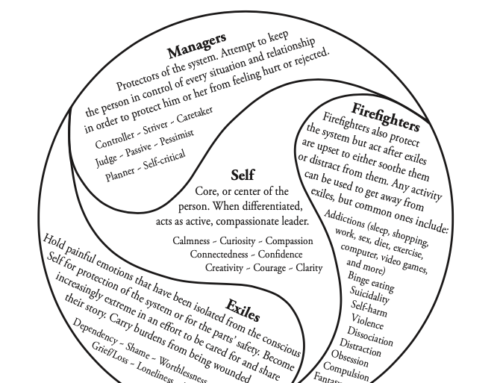Have you ever been in the situation where you are engaging in a social situation and someone says something to you or does something to you, that makes you feel uncomfortable or challenges your self-image, or self-concept? Alternatively, you might have been in a situation where you felt threatened in some other way. What happened to you in that situation? Did you notice that your ‘fight, flight, freeze response’ was activated?
You may have found that you started to criticise yourself and say nasty things to yourself. You might have felt the urge to flee or isolate, and you might have actually acted on that urge. Or you may have ruminated over the incident in your mind. Going round and round in circles and worrying about the issue in your mind. These are all ways that our fight, flight, freeze response show up in modern society, where we are not in physical danger.
Threat system – the reptilian brain
All of these reactions are common when our threat system is activated. Our threat system is part of our ‘reptilian brain’ and developed to keep us safe from physical danger. However, now that we do not often find ourselves in physical danger, this same threat system can become activated when our sense of self-image or self-concept is threatened.
If you find yourself in this situation, there is hope. Because if you employ the right skills you can move from the threat system in your brain to the attachment system or the mammalian bonding part of the brain. This is the domain of your pre-frontal cortex. When this part of your brain is engaged, you release feel-good chemicals such as oxytocin and other love chemicals into your body. Your heart will slow down and become more open to the world around you.

Attachment system – mammalian brain
It feels good to be in the attachment system, so it can be helpful to develop skills to engage this system in your mind, whenever your threat system is activated. It is actually possible to bypass the threat system altogether and simply move between the drive system (or goal-oriented system which promotes dopamine), and the attachment system. You can thereby bypass the threat system altogether.
In order to trigger the attachment system, there are three things that can help. One is the sense of touch, similar to that that is given by mammals to their young. The second is warmth. The third is soothing sounds. The idea is that you should think about a small kitten when you are imagining finding yourself in the attachment system. You touch the kitten softly, soothe it with your voice, or to hear its soothing purring. Or a mother licks her baby kitten and keeps it warm near her body.

The physiology of self-criticism and self-compassion
So, if you find yourself ruminating after something upsets you in your life, or you find yourself wanting to flee from a situation, or you find yourself being self-critical, your amygdala is generally switched on. This activates your threat system. In these kinds of situations the following behaviours will help each of the three different responses. The fight, flight, freeze response can be turned inward to create the stress response in the table below. The last item in each row is the self-compassionate behaviour that can soothe your stress response and help you to feel better and more attached.
Stress response | Stress response turned inward | Self-compassion
Fight | Self-criticism | Self-kindness
Flight |Isolation | Common humanity
Freeze | Rumination | Mindfulness
These strategies definitely help the fight, flight, freeze response
You might find that there are some times in your life where you are more likely to have your threat system activated than others. This is often due to hormonal cycles too. However, no matter where you are, if your threat system is activated you can use the three different tactics to get back to an attachment system.
For example, I will put my hand on my heart, and touch my face or body in a soothing fashion. I will also put on a jumper, or snuggle a little in bed. Thirdly, and perhaps the most effective for me personally, is to listen to some music. It is amazing how transforming the power of music can be to the threat system. Over time, it allows the attachment system to re-engage.
If you are especially prone to rumination, based on the table above, it might be useful to learn how to do a mindfulness practice when this threat system is activated as well. It feels like a hard thing to try and achieve when threatened, but I hope we learn how!
Have you felt as though you are being unkind to yourself lately, or as though you have been threatened in terms of your self-concept or self-image? What did you find worked for you to bring you back to a place of emotional safety?
REFERENCES:
Neff, K and Germer, C, 2018, ‘The Mindful Self-Compassion Workbook’ The Guilford Press. New York.
“Kittens” by www.metaphoricalplatypus.com is licensed under CC BY 2.0
“Newborn Portrait Session” by kristaguenin is licensed under CC BY-NC-ND 2.0
“Kittens May 2013” by Eredien is licensed under CC BY-NC-SA 2.0






Leave A Comment